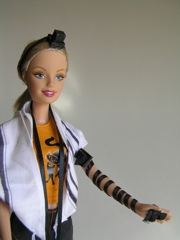 I often get asked “Do you think women should wear tefillin?”
I often get asked “Do you think women should wear tefillin?”
Let’s contextualise. Do I think all women should wear tefillin? No. For starters, I certainly don’t think non-Jewish women should be required to wear tefillin.
All Jewish women? No. Tefillin are traditionally a men’s thing; there are plenty of communities where gender roles are still rigidly defined and those communities are quite happy that way. Expecting these women to wear tefillin would be an alien cultural imposition. It would be like saying that Europeans should observe Thanksgiving – absolutely, ridiculously, acontextual.
All Jewish women in communities where gender roles are not so rigidly defined? Likewise no. There are plenty of egalitarian communities where the language of “should” is inappropriate. Any community which does not define itself as bound by the halakhic system will view the wearing of tefillin as optional. Expecting women or men in these communities to wear tefillin is akin to saying that Americans should celebrate Hallowe’en – clearly an inappropriate expectation since Hallowe’en is optional. It’s not your place or mine to pass comment on whether someone should dress up and pass out candy, and likewise it’s not our place to comment on whether someone who doesn’t see himself as bound by commandments should be observing this particular aspect of ritual commandment. Whether he does or whether he doesn’t, his choice is legitimate and deserves respect.
In communities which are professedly egalitarian and bound by halakha? Yes, I think women in these communities should be expected to wear tefillin.
The present practice of having egalitarian prayer but only expecting men to wear tefillin is shameful. The message is either that tefillin do not matter, which in a professedly halakhic community is resoundingly inappropriate, or that egalitarianism has different requirements for men and for women, which devalues egalitarianism.
So yes, in communities which accept halakha – including as it does the commandment to wear tefillin – as binding, and which aspire to accord equal rights and responsibilities to men and to women, I think that women should wear tefillin. The alternative is an egalitarianism which not only devalues egalitarianism but devalues Judaism, by demonstrating that egalitarianism is not much more than a feeble sop to women’s feelings, and a sop, at that, obtained by discarding ritual structure.
By tacitly exempting women from wearing tefillin, these communities admit that the women do not really have the same communal status as men, since all rights come with attendant responsibilities, and in any community responsibility is what is significant in the long term. If we exempt women but wish everyone to be equal, everyone must be exempt, which says that tefillin – and by extension all commandments, which form the underlying structure of this community’s Judaism – can be dispensed with. Egalitarianism is at best a fundamental development which elevates women to the same societal plane as men. This egalitarianism produces only the illusion of elevation, or levels the planes by razing the structure.
I happen to fall in the segment of the Jewish world which wants to retain halakhic structure, but wishes to see men and women as comparable elements of that structure, which is to say having comparable responsibilities and rights. Whom we expect to wear tefillin is illustrative of how we are choosing to value the one against the other. If we expect women to wear tefillin, and apply a similar attitude to other aspects of both egalitarianism and halakha, we will be further towards creating a strong halakhic structure through which both men and women may move freely. This is the context in which I think women should wear tefillin.
